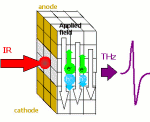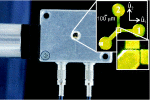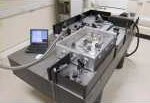- Current Research
-
The Oxford Terahertz Photonics Group studies the dynamics of low-energy (~meV) physical processes in inorganic and organic systems on a femtosecond timescale. Our research involves a combination of terahertz time-domain spectroscopy, optical-pump THz-probe spectroscopy and carrier dynamics modelling to study these processes. We also develop new ultrafast terahertz technologies and experimental methods that enable us to expand our spectroscopic tool kit. At present we are studying electronic processes in ion implanted semiconductors, semiconductor nanostructures, and organic semiconductors.
- Terahertz Emission from Semiconductors: Carrier Dynamics Modelling and Experiment
-
 |
We have developed a three dimensional carrier dynamics simulation to model ultrafast processes in, and terahertz emission from, photo-excited semiconductors.
[more]
The combination of experiment and simulation has allowed the understanding of a number of important issues in terahertz science and technology, including:
- THz generation from semiconductor surfaces - the relative importance of surface field and photo-Dember mechanisms
[more]
- The mechanism of magnetic field enhanced THz generation
[more]
- THz generation from photoconductive switches/antennae, including the role of surface chemistry and anode enhancement effects.
- Optimisation of ion damaged materials for broad-bandwidth THz emitters
[more]
- Suitable materials for terahertz emitters and detectors excited with 1.55μm micron lasers
[more]
|
-
Polarisation sensitive terahertz detection
-
 |
In 2005 we developed a terahertz sensor which records the full
polarisation state of a terahertz pulse in a single measurement. Until
recently most spectroscopic studies at far infrared frequencies have
been restricted to measurements of linearly polarised radiation. This
has made it difficult to investigate polarisation dependent properties
of materials such as birefringence, optical activity and circular
dichroism. Our new photoconductive sensor is capable of
measuring both transverse components of a terahertz pulse possessing
arbitrary polarisation. Therefore, this sensor technology allows the
power of traditional THz time-domain spectroscopy to be expanded into
new spectroscopic applications, especially in the fields of biochemistry, biology,
and organic semiconductor research.
- Development of a three contact photoconductive detector of THz radiation
[more]
- Characterisation of the frequency-dependent birefringence of quartz
[more]
|
- Terahertz spectroscopy
-
 |
We study a range of inorganic and organic physical systems using both terahertz time-domain spectroscopy and optical-pump terahertz-probe spectroscopy. We can measure samples at low temperatures and in high magnetic field.
Recent spectroscopic studies include:
- Ultrafast conductivity of surface-passivated GaAs
[more]
- Hole trapping in polymer transistors
[more]
- Charge carrier dynamics in multi energy ion-implanted semiconductors
[more]
- Vibrational modes and conformational transitions in organic materials (phenyelene oligomers)
[more]
- Phonon polariton modes
[more]
- Characterisation of far-infrared filters for particle accelerator diagnostics
|
|
|


